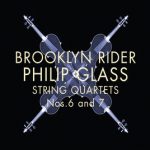One of the most ardent and true purveyors of string quartet music in our time, Brooklyn Rider is a perfect match for the music of PHILIP GLASS. Whether blazing Balkan an gypsy music, collaborating with BELA FLECK, or leading us down the byways of modern composers, Brooklyn Rider is the best. – Gene Berger.

It’s often said that the distilled essence of composers can be heard in their string quartets. And so it is with Glass, whose quartets here show a craftsman of considerable invention. String Quartet No. 6 begins as a bustling burst of dense energy, its second movement beautifully meandering, rich, and complex. The single-movement String Quartet No. 7 is almost Beethovenian in its restless questioning. Arranged for string quartet (with two violas), the Saxophone Quartet is warmly scored and yet shows Glass at his most forensic, with each bar stunningly sculpted.

Richard Guerin, who oversees Glass’ massive musical legacy at Orange Mountain Music, writes about Brooklyn Rider and Glass coming together again for the first time since 2011 in a wonderful essay entitled GLASS NOTES: BROOKLYN RIDER AND THE MUSIC OF PHILIP GLASS:
“Glass hadn’t composed a numbered string quartet in 22 years before the 2013 premier of String Quartet No.6 in Vancouver. No.6 is most definitely the most different quartet in Glass’ catalog. Composed around the time of his opera The Lost (Spuren Der Verirrten) which plays openly on the European school of modernism of the 20th century, String Quartet No.6 is Glass most challenging and thorny piece in the medium. It’s heavily layered and textured and follows no previously established model in the composer’s body of work. It is a probing piece, one that looks for answers whether they are to be found or not. It’s representative of a strain in Glass’ recent period of music which can be described as more musically active, densely harmonic, and bustling with a different kind of energy, more so than any of his music from the previous 50 years.

Apart from the proper string quartets, in 1995 Glass once again approached four part writing in his Concerto for Saxophone Quartet and Orchestra. Part of that commission was to compose two versions: one for soloists and orchestra and a separate version for saxophone quartet alone. The piece has been popular to the point where saxophone quartets began making arrangements of Glass’ string quartets. Brooklyn Rider decided to go the other way and for the first time to arrange Glass’ Saxophone Quartet for string quartet. It’s a wonderful arrangement and works well. The key to the piece opening itself to them happened when they decided to use two violas instead of two violins.
In a phone conversation in early 2014 Glass and I discussed the prospect of recording String Quartet No.6. At 24 minutes, the piece would not be long enough for a conventional album. We considered what other music for quartet might be included in a possible recording. I mentioned the music from Dracula as a concert suite or perhaps arrangement of music from his opera In the Penal Colony which is scored for string quintet. Glass responded with, “How about String Quartet No.7?” Confused, “I said what will String Quartet No.7 be? When will you write it?” Glass responded that it had already been written and was about to premiere as a dance piece in Amsterdam as part of the Colours International Dance Festival, performed by Kronos Quartet choreographed by Sol León and Paul Lightfoot.
Now one needs to understand that I pay more attention to performances of Philip Glass’ music perhaps more than anyone else in the world as a fan and as part of my job. I enter every performance date into the calendar on Glass’ website. I was totally unaware that this new piece had been written and was about to premiere. But more than anything, it was surprising that after not having written a string quartet for over two decades, the composer had decided to write two within the period of a calendar year. Whereas String Quartet No.6 was highly unusual and totally different than its predecessors, String Quartet No.7 stands in total contrast to its siblings. The piece belongs firmly to what I think of as being characteristic of Glass’ “late” period along with pieces like Etude No.20, the final movement of the Second Partita for Solo Cello, and the finale of the recent Piano Concerto No.3
All of Glass’ quartets are in multiple movements. String Quartet No.7 is the only piece in a single unified slow movement that is just under 17 minutes long. String Quartet No.7 is some of the most honest and direct music Glass has ever written. From the opening bars there’s a simplicity of discourse which lasts for the entirety of the piece. To some extent, String Quartet No.5 and No.6 are pieces built on complexity. They are forward looking pieces and they are pieces with something to prove. String Quartet No.7 exists as a piece by an artist free of expectation of any kind. Free from history. Free from himself.
It’s this last point which I think is the most salient. No.5 was an attempt at touching upon that most serious subject of pure musicality. No.6 is a loaded reaction, an epitaph to modernism. No.7 is a kind of “late” music where perhaps nothing more should be said about a subject. It’s the last line of finality after which nothing else seems appropriate. To that extent, the music lineage of what he started back in 1966 with No.1 came to a definite close with String Quartet No.7 and there could be no better ensemble to be exponents for this music than Brooklyn Rider.”
“String Quartets Nos 6 & 7” is in-stock now at Horizon Records, along with these other Brooklyn Rider titles.















































